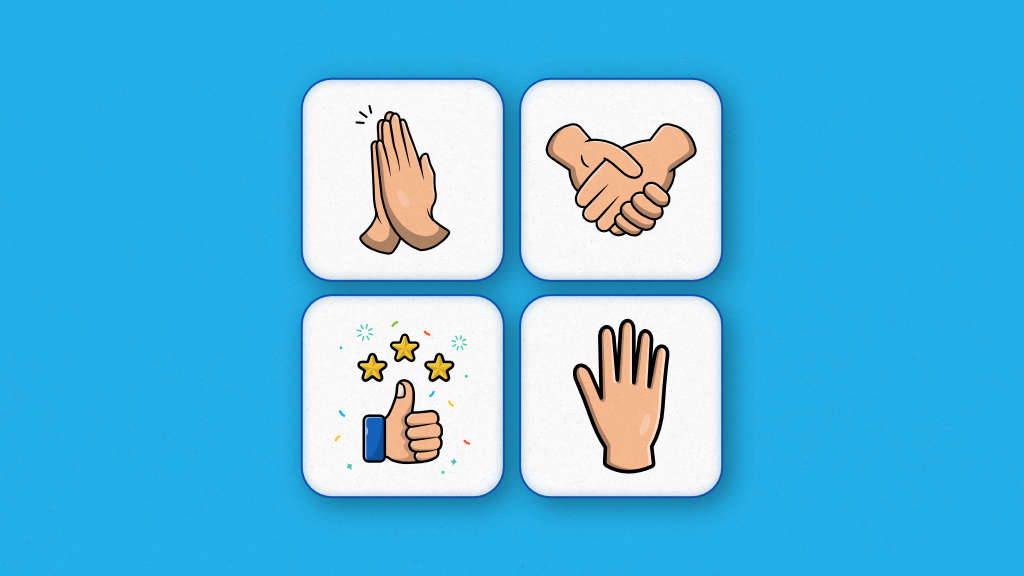Introduction
Communication is the process of sharing information, ideas, and feelings. It helps us connect, solve problems, and build stronger relationships.
There are two main types of communication: verbal and nonverbal. In this article, we’ll talk about nonverbal communication. It’s a big part of how we interact during meetings, discussions, and everyday life. Nonverbal cues and paralanguage—like gestures, facial expressions, and body language—can show how we’re feeling or what we really mean, even without words.
Nonverbal communication is different from speaking or writing. It relies on signals our body sends—such as a smile, a nod, or even our posture. Learning how to use and understand these cues can make conversations smoother, help build trust, and improve your leadership skills.
It might be surprising, but we all show similar behaviors in stressful situations and daily interactions. Emotions are a natural part of life, and mastering nonverbal cues is essential. These skills can help you build deeper connections with others.
Let’s get started!
What is nonverbal communication?
Nonverbal communication is conveying the message through body language, facial expressions, eye contact, gestures, and body posture.
During conversations, body language helps send the message with emotion or feelings. Body language is an essential part of communication. It’s important not just in your personal life but in your professional life as well.
Stakeholders, managers, leaders, and team members can benefit by mastering nonverbal communication. It helps in many ways, such as:
- Help to communicate better
- Helps to convey a message with emotions
- Helps to increase trust
- Helps to build more relationships with others
Why nonverbal communication is important?
Here is an interesting fact to emphasise the importance of non-verbal communication.
We use less than 7% of words in communication. About 55% of communication is nonverbal, while 38% is vocal.
Non-verbal communication gestures simplify communication in the workplace. As managers, we must ensure that our team members are comfortable with their surroundings and on the same page.
The importance of nonverbal communication includes:
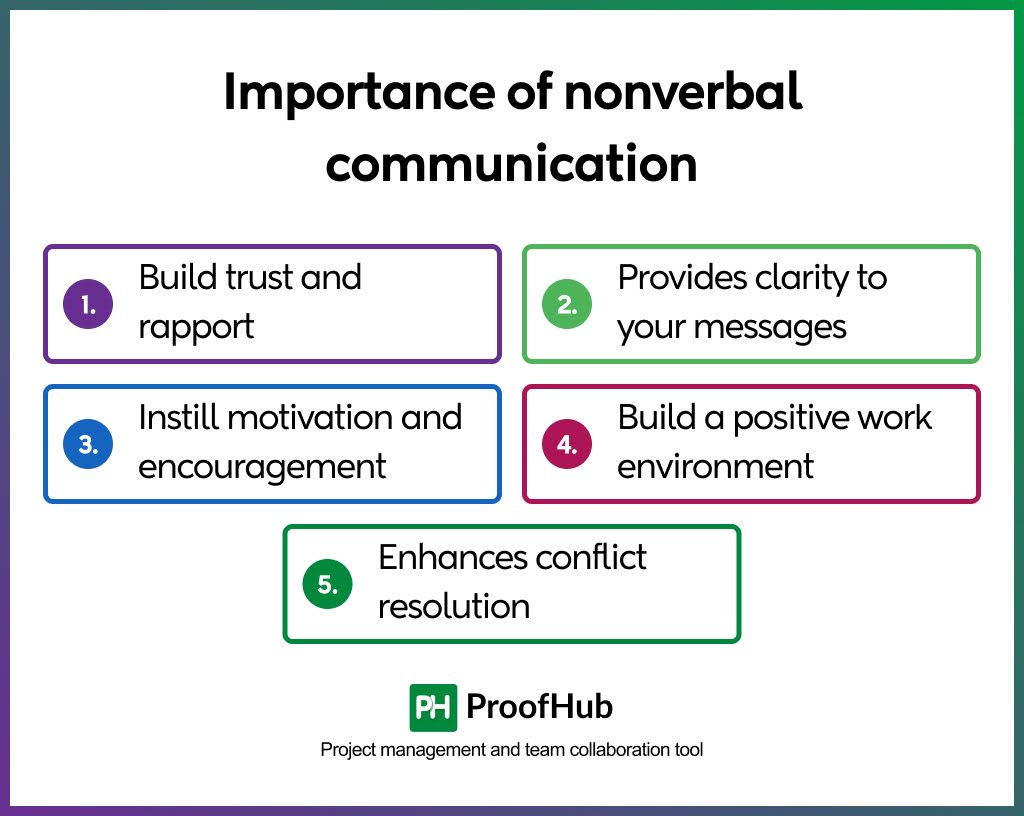
1. Build trust and rapport
Nonverbal cues come in handy to build trust and rapport with your team members. Maintaining steady eye contact and a warm smile builds an environment of trust and open engagement. Managers have this innate responsibility to hold team members together.
When you avoid eye contact, talk with a rude tone, or avoid smiling, your team members will refrain from engaging in conversations with you. This leads to a build-up of nervousness, discomfort, and dishonesty.
2. Provides clarity to your messages
Nonverbal cues and gestures highlight your verbal messages. Your verbal and nonverbal expressions should complement each other. Together, these entities help your team members understand your message with ease.
A simple example includes clasping your hands when giving out an appreciative message or banging your hands on the table when giving out an angry message.
3. Instill motivation and encouragement
Remember the famous old saying: “A picture is worth a thousand words.”
You need not even speak a single word but still convey a message to your team members. Facial expression, body language, and behavior convey your message and feelings to your team members.
The same applies to every slight facial reaction you portray in your workplace. Facial expressions are universal. Your team members would quickly spot the difference between a fake smile and a genuine one.
So, the next time you walk into the office in the morning, ensure you use healthy body language. Your verbal wishes are secondary and less essential than nonverbal gestures or expressions.
4. Build a positive work environment
Nonverbal communication sets the tone for positivity in the workplace. Openness, respect, and inclusivity are portrayed through gestures, active listening, and inclusivity.
Imagine your team members’ confusion when you appreciate them but follow up with slow claps. Sarcasm and contradictory gestures build up an imbalance in the workplace. Your team members lose trust and spend time trying to analyze your behavior.
5. Enhances conflict resolution
Nonverbal communication plays an essential role in resolving conflicts effectively. With the help of nonverbal communication cues like; calm posture, facial expressions, and open body language, you can handle tense situations and resolve conflicts between the people involved.
Example: During a team disagreement, a manager leans forward, maintains steady eye contact, and keeps a calm expression. This nonverbal communication helps de-escalate the situation, encouraging both team members to share their concerns calmly and work towards a solution.
Build a centralized channel for sharing real-time information and updates using the best employee communication software.
What are the types of nonverbal communication?
Different forms of nonverbal communication come in handy during various stages of communication. When you combine these nonverbal gestures to communicate, you will be able to deliver messages with ease.
The most widely used nonverbal communication includes:
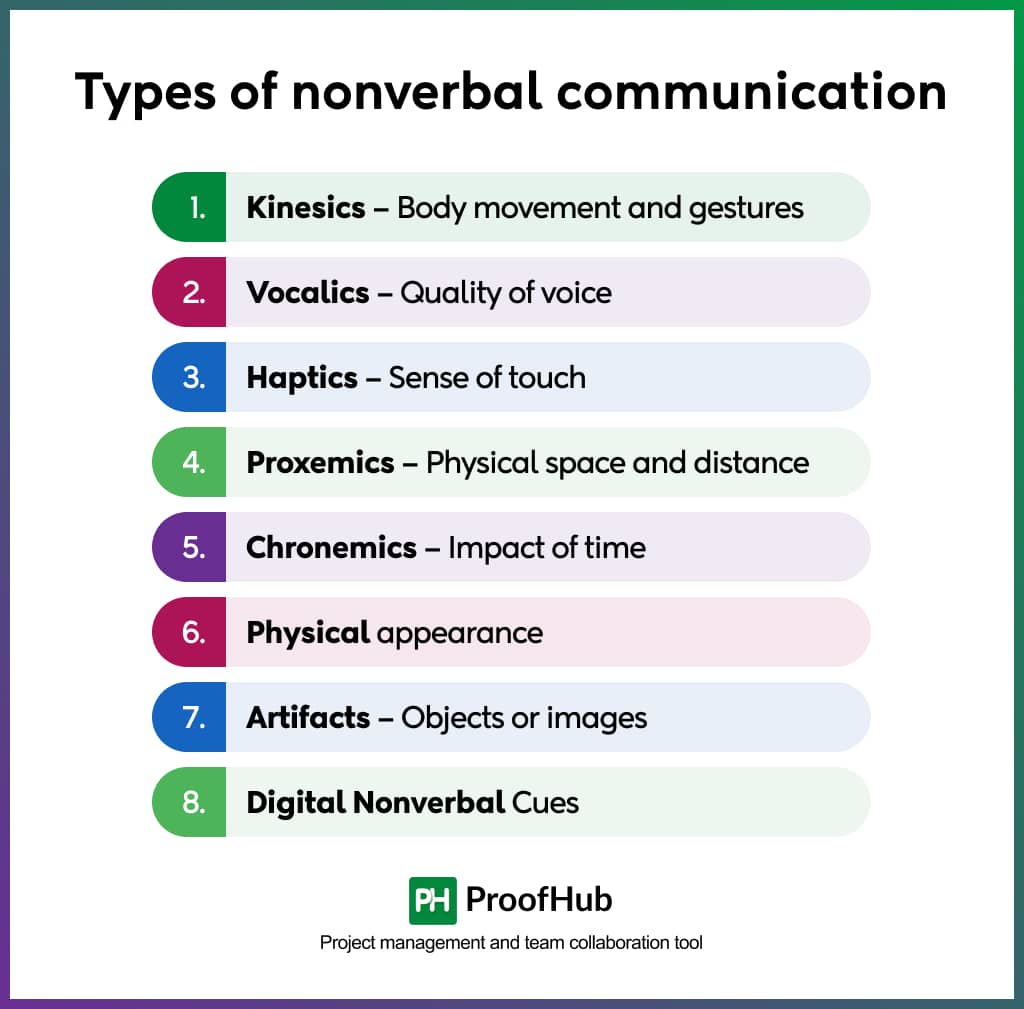
1. Kinesics – Body movement and gestures
Gestures and body movements are deliberate signals that send out an impactful message to your team members. Waving and pointing out a thumbs-up are quite common gestures across the globe. Many different gestures and movements have different meanings in various regions.
Gestures and body movements hold significant importance when it comes to communication. Minute movements in the form of eye roll, tapping your foot, winking, tossing your hair, and others are all examples of body movement and gestures with different meanings.
2. Vocalics – Quality of voice
Nonverbal communication considers the pitch, volume, rate, and vocal quality of the person conveying information. Breathing space, laughing, and other filters like “uh” or “um” also vary according to the information you need to pass on.
This factor indicates the emotional expression and the intelligence quotient of the person. You will be able to understand the pain or the emotion your team member is trying to express. This helps you build an effective bond with your employees in such a situation.
Read more – What is effective communication? [with benefits and tips]
3. Haptics – Sense of touch
Haptic communication involves the sense of touch. You can use touch to send out a piece of subtle information. Haptics are primarily involved when you want to appreciate someone. This could include a pat on the back or a partial embrace. The sense of touch provides a calming or appreciative effect when done correctly.
However, not every team member would react the same way regarding touch. You need to be careful when patting or embracing your employees. After all, their comfort is significant while adopting nonverbal communication in the workplace.
4. Proxemics – Physical space and distance
Distance between you and your team members indicates the conversation’s comfort level. This helps ensure the smooth flow of information. Proxemic zones are separated into intimate, personal, social, and public (or professional) spaces.
The intimate zone has a proximity of 18 inches, while the public zone has a proximity of up to 4 feet. Additionally, people generally tend to be closer to the ones they are comfortable with while maintaining a safe and far distance from unknowns.
5. Chronemics – Impact of time
The time you take to reply to a conversation impacts the overall value and worth of the communication. Chronemics is given value, especially in remote or hybrid working formats. Significant and frequent delays and excuses build up an uncomfortable environment.
Chronemics include arriving on time, starting a meeting on time, concluding a discussion on time, etc. These factors signify the respect and regard you hold for your team members. You need to understand that time is your employees’ most precious resource. Ensure that you do not misuse this resource.
6. Physical appearance
When it comes to influencing your team members with nonverbal cues, several factors come into consideration. Be it your height, weight, or appearance, everything matters. Since the early stages of evolution, height has been the key factor ascribed leadership qualities to people. Height and appearance brought in aspects to convince fellow members and exercise authority.
However, your physical appearance should not be solely used as a leadership symbol. Even tall leaders are expected to bow down and listen to the pleas and requests of individual team members. This enhances internal communication among the members and improves team bonding.
7. Artifacts – Objects or images
“First impression is the last impression.” I am sure you must have heard this quote from your childhood. But how do you establish a good first impression?
Your dress and the accessories that you carry establish your first impression. People tend to observe your clothes first, more so your shoes. By dressing up better, you can build an effective first impression.
Accessories play a crucial role, especially for women. This includes jewellery, scarves, handbags, caps, and other items. They depict the nature of the women and their intentions.
8. Digital Nonverbal Cues
With technological advancements, the emphasis shifts towards more diverse, scattered, and remote teams. This is where you need digital assistance for smooth communication within your team.
With ProofHub, you get an all-in-one, robust, centralized platform for all your communication requirements. The built-in chat helps you to quickly convey messages and share important information and files with your team members. You can use emojis and GIFs to lighten the mood and easily convey emotions.
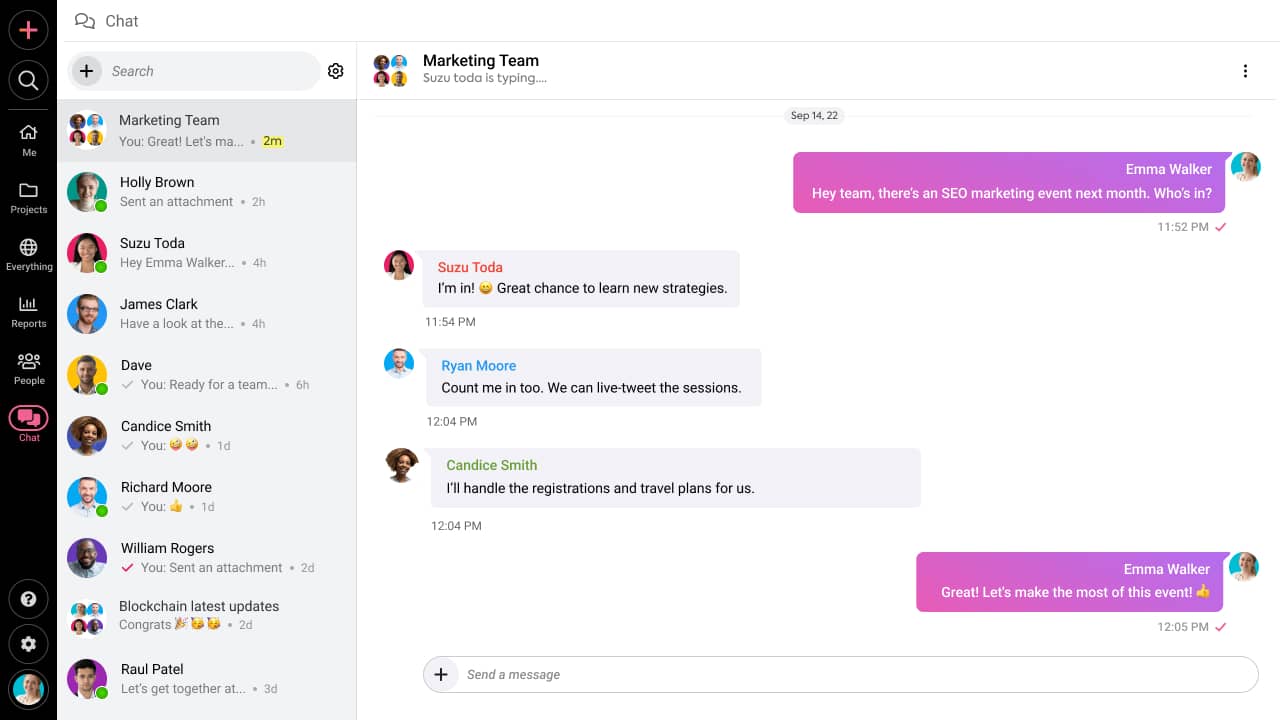
Comments and Discussions provide an organized and streamlined flow for holding all information accessible to all team members as needed. This provides an environment for teams working from diverse locations to collaborate and work together.
Examples of nonverbal communication
Now that we have understood the eight types of nonverbal communication let us apply them practically. In this section, we will see different examples of nonverbal methods of communication.
For each example, picture yourself in that scenario. This will help you understand the context and portray your aura with confidence.
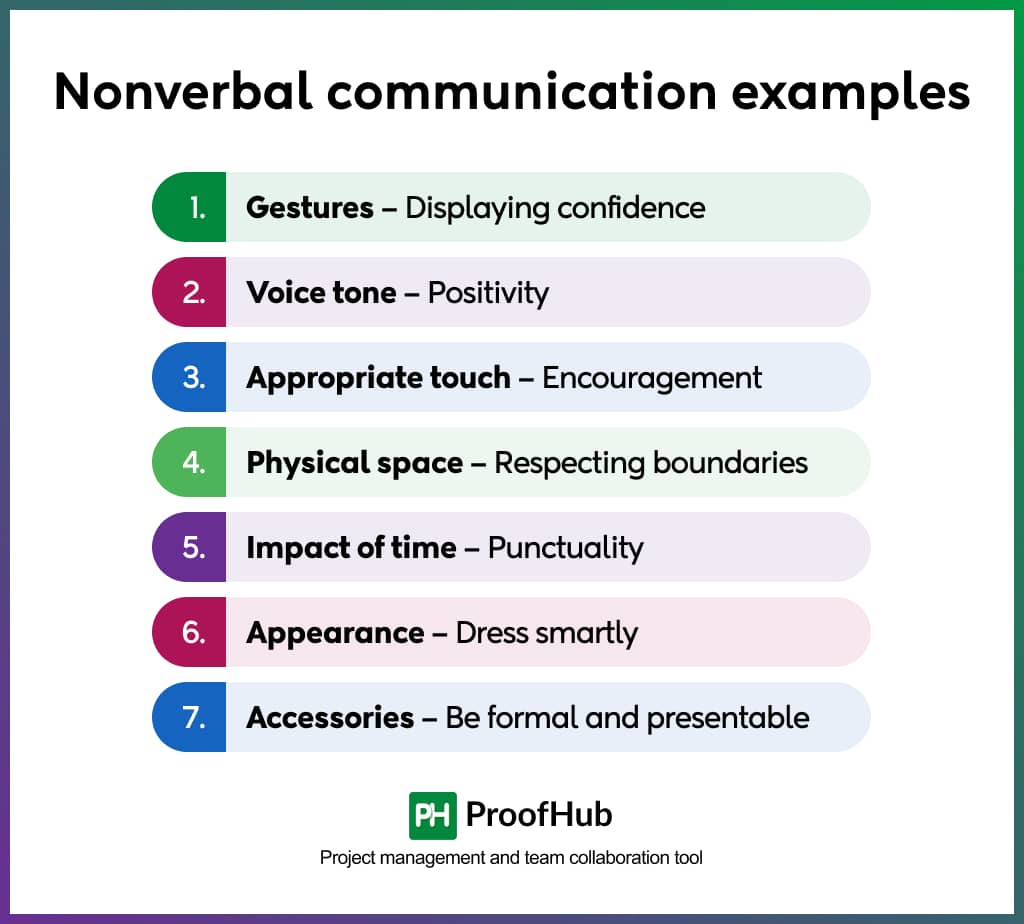
1. Gestures – Displaying confidence
When giving a presentation, hold back your shoulders. This will provide confidence in your demonstration. Your team members will listen with intent, affirming your leadership authority. Lack of trust is shown when you slouch or put your hands inside your pocket to hide fear, nervousness, and anxiety.
2. Voice tone – Positivity
You are explaining a new project to your team members. It is essential for you to sound enthusiastic and motivated. Holding a positive tone shows you are excited about the new project. This will serve as the boost your team members need to get a headstart on the new project.
3. Appropriate touch – Encouragement
Haptics play a crucial role in encouragement, motivation, and reassurance. The sense of touch provides comfort to the receiver. Patting on the back or a side embrace are simple ways to appreciate your team members. A stern handshake indicates that you are fully confident and trust that person.
Note: A stern handshake is friendly in most parts of the world. However, in certain places, it is considered a symbol of dominance and a display of aggression.
4. Physical space – Respecting boundaries
When having a face-to-face interaction with your team member, decide the seat close to each other before you sit. Moving close or far away during a conversation will indicate that you are not interested in the conversation. Further, your team members may misjudge your intention.
Note: When you sit or move too close to your team members, you would invade their personal space. Intruding boundaries would make your team members uncomfortable and insecure.
5. Impact of time – Punctuality
Regarding the impact of time on nonverbal communication, punctuality is the key. Never be late to meetings. Always start and conclude meetings and discussions on time. Further, understand the attention span of your team members. This will help you to hold discussions and meetings that convey clarity to your team members.
6. Appearance – Dress smartly
Your attire is formal and suitable for the occasion. By dressing up in formals, you indicate that you are motivated and come to the workplace enthusiastically every morning. A shirt and pants are the most simple and comfortable workplace attire. The colour of your dress sends out a silent message of your mood.
7. Accessories – Be formal and presentable
The accessories that you hold vary for both genders. For men, shoes, ties, and belts are visible. Further, your hairstyle, beard, and moustache portray an image of who you are. Short hair for men and a ponytail for women indicates confidence. Hair colouring, piercings, and tattoos are being slowly accepted in mainstream offices with lower judgments than before.
What are the key elements of nonverbal communication?
Giving out mixed signals puts your team members and your peers in a state of confusion. If there is a variation between what you say and your body gestures, your team members will have difficulty perceiving the information.
To enhance your nonverbal methods of communication the following three elements play a very important role. This includes:
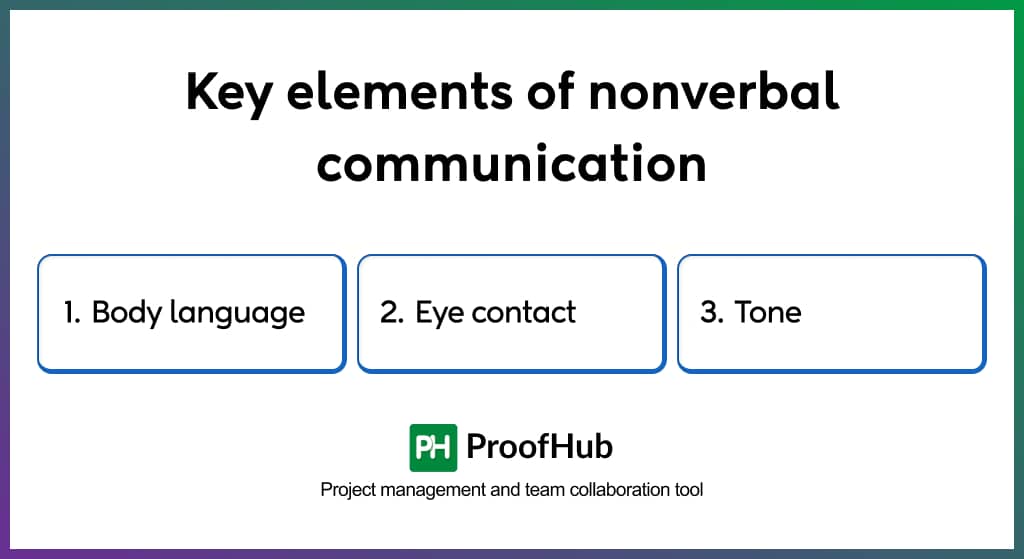
1. Body language
The primary role in communication is through body language and gestures. Every movement of your body during a conversation indicates your involvement and interest.
When listening to your team members, leaning forward indicates that you are interested in listening to them. Further, crossed arms and legs indicate you are not open to what is being said.
2. Eye contact
A minimum of 4-5 seconds of steady eye contact is necessary to ensure that you are interested in the conversation. Visual perception helps you.
Steady and healthy eye contact is essential to build trust. This promotes a healthy rapport and keeps conversations flowing. Effective visual communication aids in building trust and a positive work environment.
Excessive eye contact results in staring. This causes discomfort to both parties. Further, while breaking eye contact, avoid looking down; instead, look to the sides.
3. Tone
Vocal tone includes the pace, volume, and pitch of your speech. These attributes provide an honest image of the speaker’s message.
Your tone is key in differentiating frustration, sarcasm, agreement, confidence, and other emotions. Delivering a message in a monotonous tone does not hold the attention of your team members.
Keep your team members updated and informed with these essential tips for communication.
What are the challenges to non-verbal communication?
Various challenges arise in nonverbal communication due to the scale of differences between different team members. Apart from cultural, regional, or religious reasons, some personal issues are prevalent among individuals.
The most common challenges that hinder nonverbal communication include:
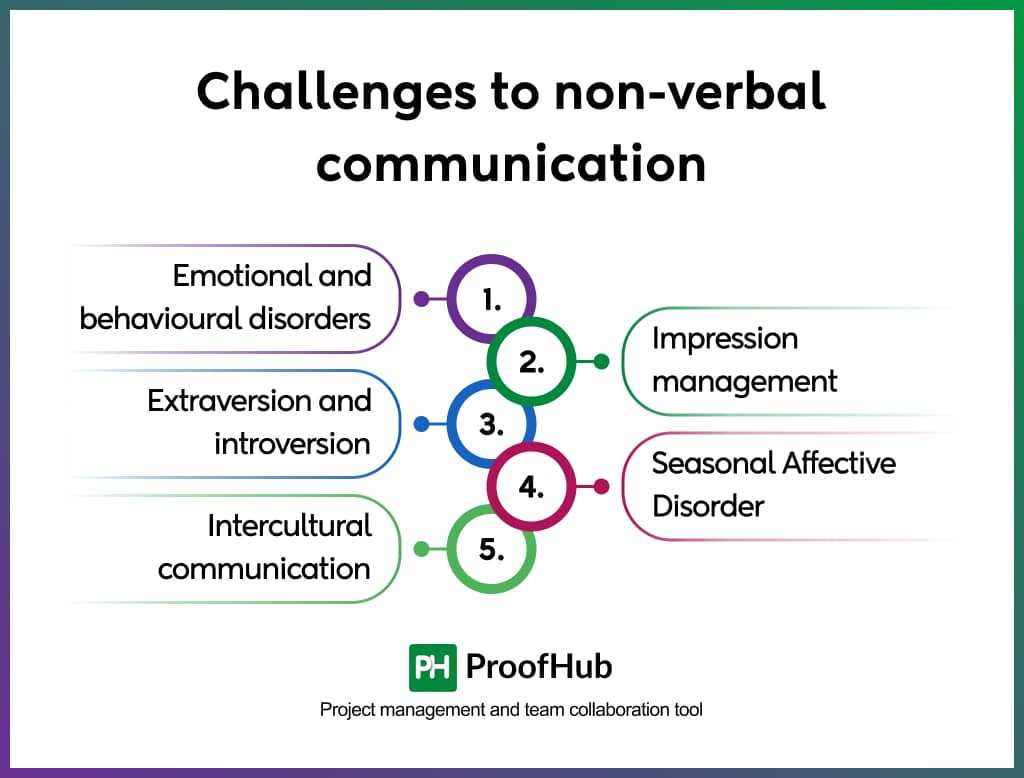
1. Emotional and behavioural disorders
Different team members have different emotions and behaviors. Their growth and several other factors influence this. You cannot separate team members with disorders or treat them separately. You must have an inclusive model.
A majority of emotional, behavioural, and mental disorders happen due to early childhood trauma. As per research, people with high childhood trauma often display a high absenteeism rate in the workplace. You will have to adopt a unique nonverbal approach to understand and converse with people going through trauma. These people would not respond to regular stimuli just like everyone else.
2. Impression management
This is a part of science that studies the behavior and performance of various team members. This data is then used to build a summary impression of the individuals. This is also termed impression formation. The problem with impression management is that team members pretend and build impressions that do not reflect their genuine characteristics.
In such misleading cases, the build-up of data and information is incorrect and, hence, not useful in the big picture. You will not be able to analyze or predict the behavior of your team members efficiently.
3. Extraversion and introversion
This is the difference from where your team members get their energy. Extraversion is a situation where team members get energy through socializing and collaboration. They are called extroverts. While introversion is the opposite, team members get energy alone or in tiny groups. They are called introverts.
It is difficult to engage both these categories together. Extroverts are open and enthusiastic, while introverts may feel left out in socialization events. You must understand the category to which your team members belong. However, you should not try to change their mindset. You should provide a comfortable workplace for each of them and ensure a steady work progression.
4. Seasonal Affective Disorder (S.A.D.)
Seasonal Affective Disorder is an irreplaceable attribute that comes in during the winter season. According to scientific studies, doctors and researchers revealed that individuals tend to go through this disorder during winter. This is because of the shorter days and low levels of sunlight.
This condition hinders stimulus modality, i.e., the individual’s response to a stimulus. In such cases, it is difficult to understand what your team members are going through.
5. Intercultural communication
Nonverbal cues play a significant role in interpersonal communication with people with regional or cultural differences. Persons belonging to a particular religious background will abstain from any physical touch. However, others are comfortable with embracing the workplace.
In other cases, even the intensity and firmness of a handshake send out a different meaning in different parts of the world. Therefore, you must know the common perceptions before proceeding with nonverbal cues.
Eliminate chaos and misunderstanding with these 9 effective communication strategies to connect better with your team.
How can we improve nonverbal communication?
Nonverbal communication can build or break your character. As a manager, you should build interpersonal relationships with your team members. I have portrayed actionable tips and strategies that will help you enhance your nonverbal communication skills.
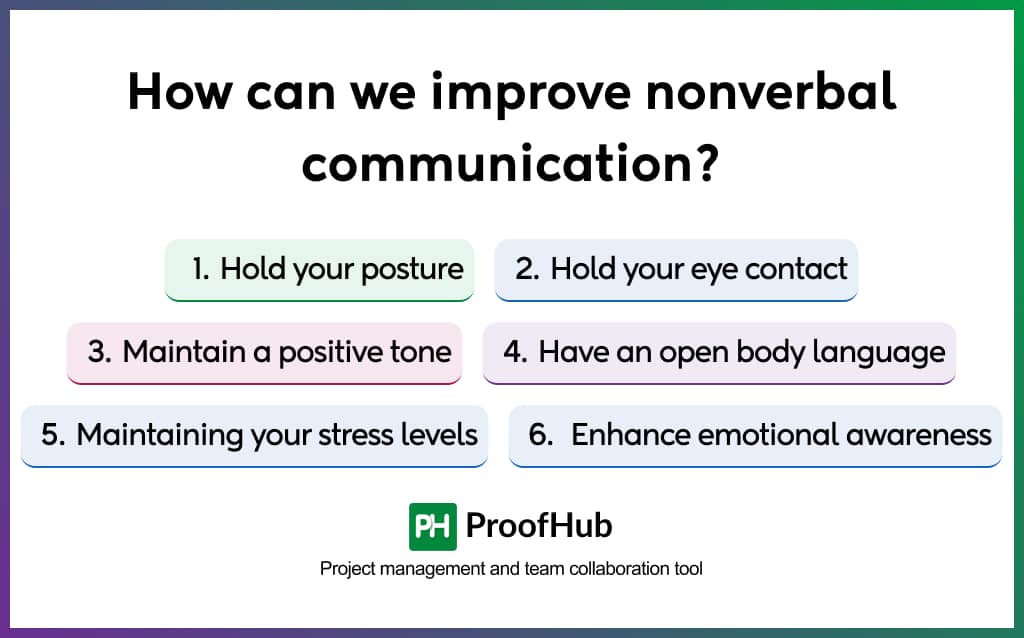
1. Hold your posture
When interacting with your team members, hold your shoulders back. Slightly lean into the conversation. This will show that you are interested in the conversation and actively listening.
2. Hold your eye contact
Look directly into the eyes of your team members. However, do not hold eye contact for more than 4-5 seconds. This leads to staring and causes an uncomfortable environment. Do not look down or continuously check your phone alerts while interacting with your team.
3. Maintain a positive tone
Your voice should match to the message that you are saying. Do not answer official phone calls when you are sleepy. Sit straight to free up your voice box. Further, your voice portrays emotions such as anger and happiness more than your words.
4. Have an open body language
In all conversations, being receptive and open to criticism is necessary. Sitting with crossed arms or legs and leaning back on your chair are indications that you are not open to suggestions. Active listening enhances your mindfulness of the present moment.
5. Maintaining your stress levels
When you are stressed out, you will not be able to understand the visual cues of your team members. Further, you will send out confusing nonverbal cues that confuse your team members. In such instances, you need to take time out and calm down.
6. Enhance your emotional awareness
Emotions are contagious. If you are upset, you make a whole lot of people upset. You should be aware of your team members’ emotions and how those affect each other. When you are emotionally aware, you will respond in an understanding manner.
Conclusion
Nonverbal communication holds the key to understanding your employees. This helps you convey messages with ease. You can confidently lead your team members when you know your employees’ gestures, visual cues, and body language.
Employees find it comfortable working with managers who can understand their nonspoken language. Additionally, a digital project management tool like ProofHub will help you improve team bonding by streamlining communication with collaboration features to be on the same page, understand workflow, and work together in tandem.
Organize your business communications and management using ProofHub. One tool for all professionals.
FAQs
What are the nonverbal cues when communicating?
Nonverbal cues include facial expressions, body language, gestures, eye contact, posture, touch, and tone of voice.
Why are nonverbal cues important?
Nonverbal cues help you communicate effectively with your team members. You can share your knowledge, thoughts and ideas with precision and ease. Nonverbal cues improve your emotional intelligence and help you understand the mindset of your team members.
What are the 4 main types of nonverbal communication?
The 4 main types of nonverbal communication include gestures, voice tone, touch, and physical appearance.
What are the 5 C's of nonverbal communication?
The 5C’s of nonverbal communication include context, clusters, unity, consistency, and culture.
What is the 7-38-55 rule?
This rule states that only 7% of our communication is verbal. While 38% of communication depends on your voice tone, the remaining 55% is through body language.
